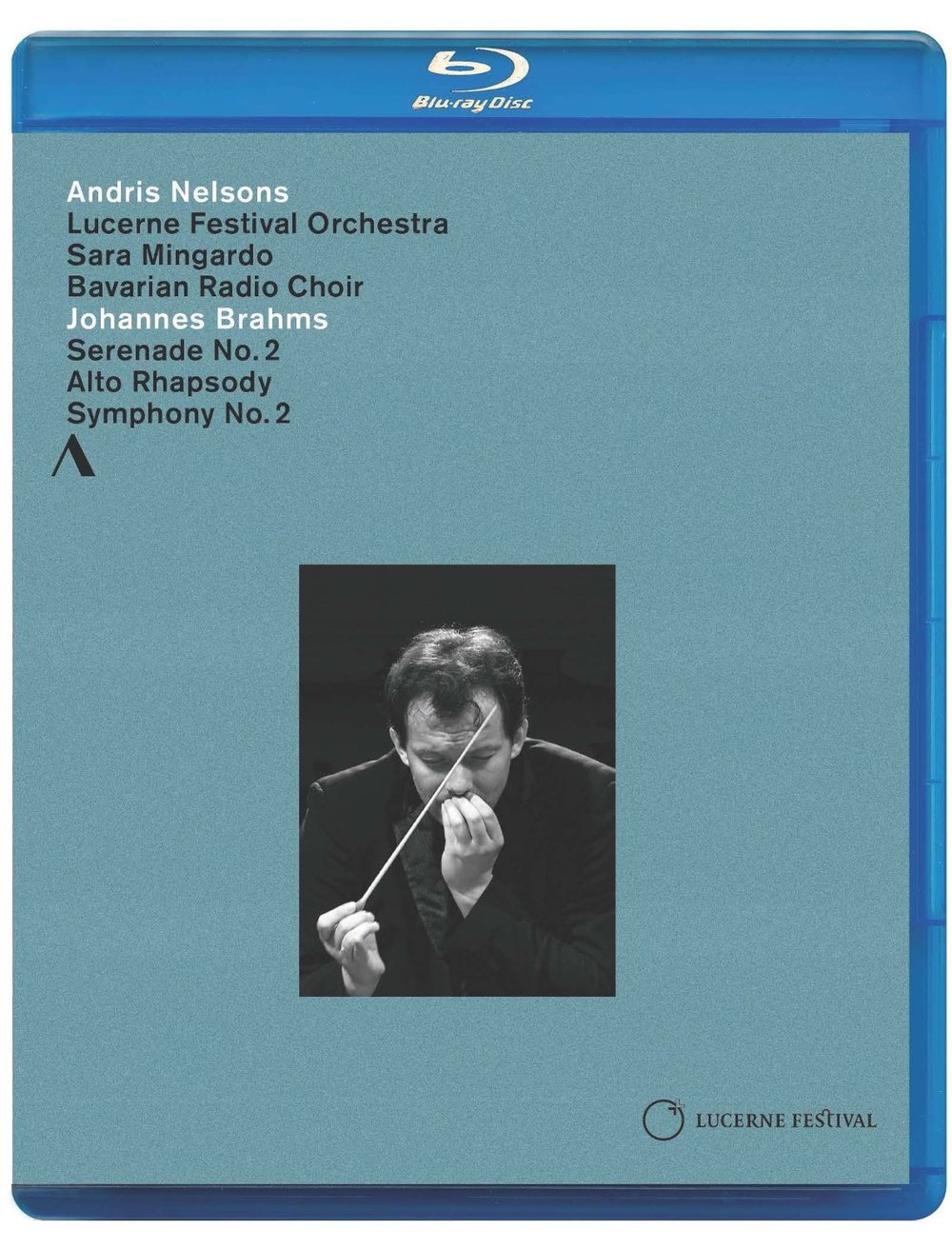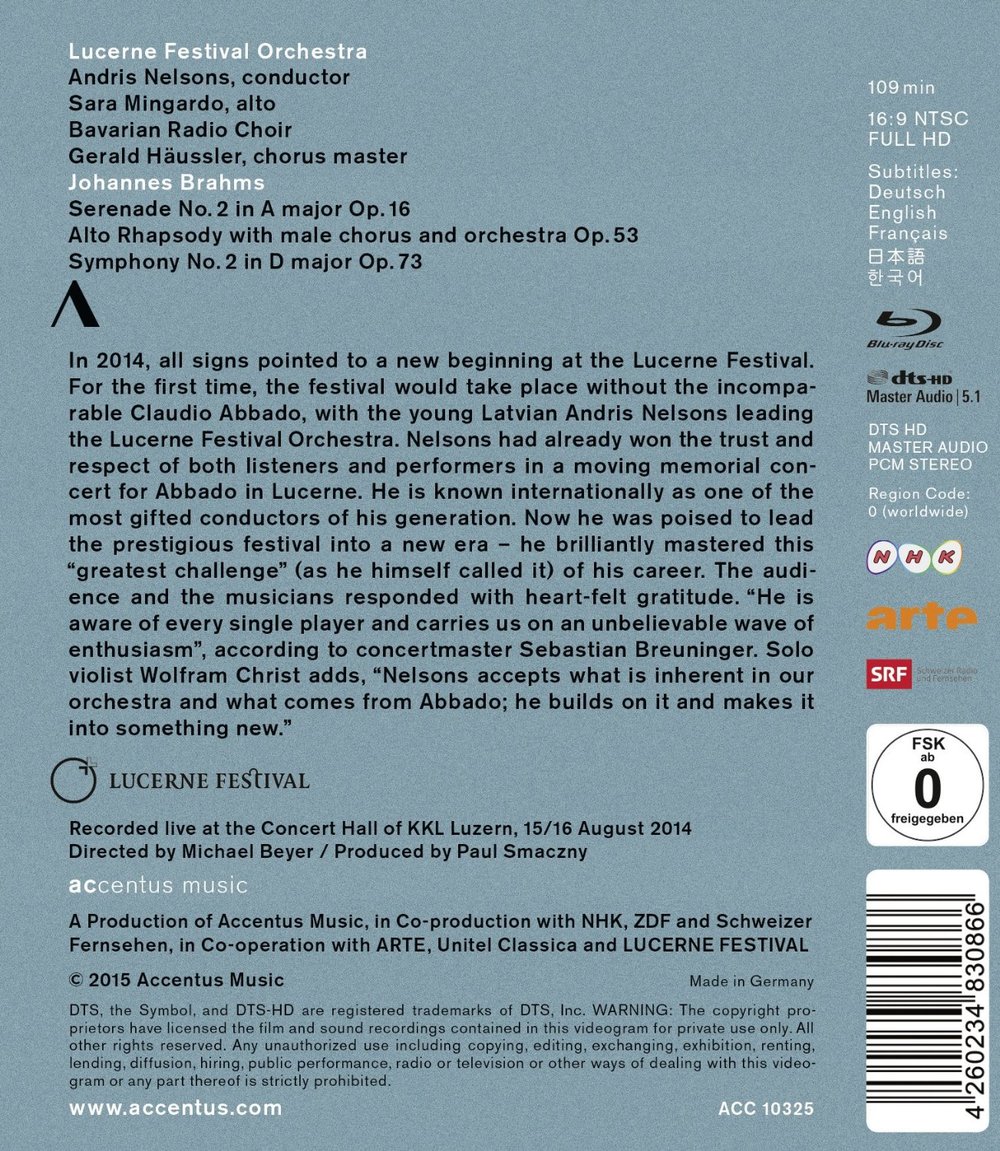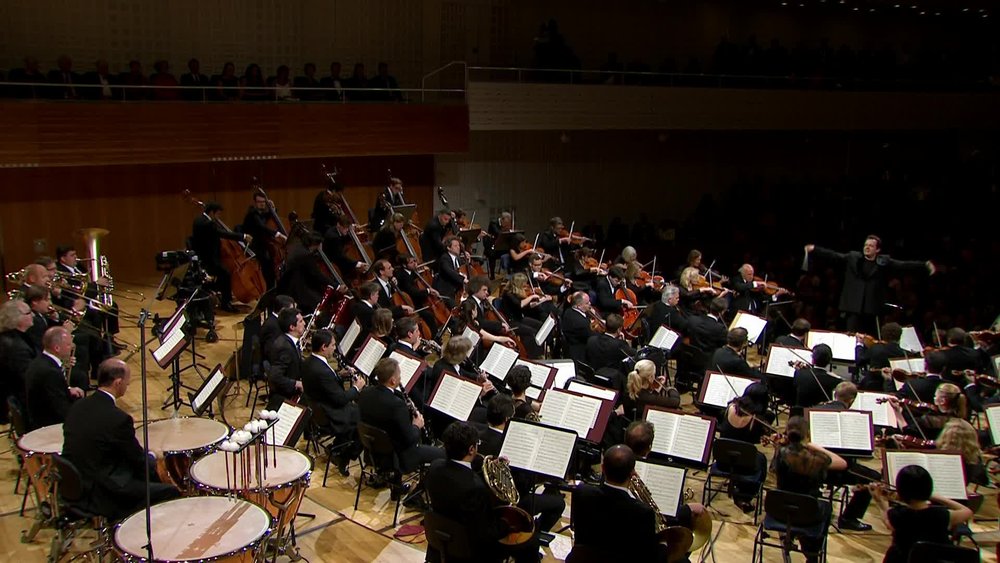

All Brahms disc with three major works: Symphony No. 2, Serenade No. 2, and the Alto Rhapsody. Andris Nelsons conducts the Lucerne Festival Orchestra and Bavarian Radio Choir in 2014 at the Lucerne Summer Festival (KKL Concert Hall). Soloist is Sara Mingardo (alto); Gerarld Häussler was Chorus Master. Directed for TV by Michael Beyer; produced by Paul Smaczny. Released 2015, disc has 5.1 dts-HD Master Audio sound. Blended Grade: D-
Richard Osborne, writing in the July 2015 Gramophone (page 30) offers caustic condemnation of this title saying that both the symphony and the serenade "fall prey to Nelson's slow and self-indulgent way with Brahms's music." He also complains that these are "performances to seen rather than heard." I think he must be referring to Nelson's hyperactive style of movement and making of faces. John Quinn, writing for musicweb-international, liked the performance better than Osborne, but even Quinn squirms repeatedly about what he deems over-expansiveness by Nelsons.
Symphony No. 2
I have long praised the Saito Kinen Brahms Symphony No. 2 published by NHK. Now let's compare the Saito Kinen/NHK version to subject Brahms 2 recorded by Michael Beyer. Here from my Wonk Worksheet for Symphony No. 2 is a summary of the types of shots in Michael Beyer's video (for explanation of the abbreviations and process below see our Wonk Worksheet form and Wonk Worksheet Instructions):
Conductor = 74
C/B = 40
Solos, S§, SG, & misc. small-scale = 237
*L§, LG, & misc. large-scale = 14
*PO = 18
*WO = 3
IO = 9
Other low value = 3 “anthill” shots between movements
There's a total of 398 clips over 51 minutes of music, which yields a pace of 7.8 seconds per clip. Supershots (those marked * above) amount to only 9% of the total clips, while the 114 conductor shots come in at 29% of the total.
,Here again are the rules-of-thumb to identify a Blu-ray with DVDitis:
A good symphony HDVD should have a slow pace with more than 10 secondYou can't see the soloist, the conductor, or any section of the orchestra. s per video clip on average (the longer the better). 20 to 40% of the clips should be large-scale "supershots." Conductor shots should be less than 20% of the clips in the video (way less really).
This video fails on all 3 tests. It further has no introductory WO shot and too many IO shots.
Now let’s look at some screenshots. I've never seen a cello player with a glove before:,
Below is the concertmaster. This shot is made from the wrong angle, a common error in symphony videos:
Next below are 3 more shots of Nelsons faces.
I assigned the shot below to the C/B category. This could be deemed a view of the lower strings, but it was clear to me while watching this that the cameraman was focusing on Nelsons:
There's only 14 large-scale shots of musicians, and below are two of them:
Next below is 1 of 18 PO clips:
Lastly, here's one of the only 3 WO shots in the entire symphony video. The first of the 3 pops up about 9 minutes into the piece, and the other 2 are in the final movement when the band is playing fff and mostly tutti:
Now that you've seen the screenshots, let's directly compare the Saito Kinen and the Lucerne/Accentus versions in the following table showing that the Saito Kinen is superior to the Lucerne version in every way:
| Aspect | Saito Kinen | Lucern |
|---|---|---|
| Total clips | 256 | 398 |
| Conductor | 33 | 74 |
| Conductor over backs | none | 40 |
| Whole orchestra views | 23 | 3 |
| Supershots | 100 | 35 |
| Supershot ratio | 39% | 9% |
| Conductor ratio | 13% | 29% |
| Pace in seconds | 10.7 | 7.8 |
| Audio specs | 96kHz/24-bit | 48kHz/24-bit |
Now to give a grade to the Lucerne recording. There are scads of fine audio recordings of Brahms S2 to pick from. A good video would make any good performance of Brahms S2 superior to most if not all of the audio offerings. But with so many good audio choices, there's no need for a bad video. With rampant DVDitis and squabbling among the expert print critics over performance quality, this Lucerne Brahms S2 in Blu-ray is obsolete, defective, and dead on arrival. Grade: F
Serenade No. 2
Brahms wrote this serenade at age 26 as a warm up for catching up with Beethoven. If you like this piece, it means you are a classical music fan to the core. PQ is fine. SQ is weak with "tubby" bass and murkiness in miking and mixing. I ran the numbers on video content and you can see my notes here on a completed Wonk Worksheet. Next below is a summary of the kinds of video clips in the Serenade:
Conductor = 64
C/B = 27
Solos, S§, SG, & misc. small-scale = 212
*L§, LG, & misc. large-scale = 6
*PO = 13
*WO = 3
IO = 6
Other low value = 3 “anthill” shots between movements
There's a total of 334 clips over 35+ minutes of music, which yields a pace of 6.6 seconds per clip. Supershots (those marked * above) amount to only 7% of the total clips, while the 138 conductor shots come in at 27% of the total.
We have established the following rules-of-thumb to identify a Blu-ray with DVDitis:
“A good symphony HDVD should have a slow pace with more than 10 seconds per video clip on average (the longer the better). 20 to 40% of the clips should be large-scale "supershots." Conductor shots should be less than 20% of the clips in the video (way less really).”
This video fails on all 3 tests, and has near-terminal DVDitis.
Now let’s look at some screen shots. The first obligation of the video director is to give the home viewer a whole-orchestra (WO) orientation shot at the beginning of the video. This Beyer fails to do. The initial WO shot should fill the screen with all the musicians so the home viewer can easily figure out where all the instruments are located. The shot below is not a whole-orchestra shot because the orchestra doesn't fill the screen. The resolution at this range is too fuzzy for the viewer to see much. So here's a pop quiz: can you figure out from the image below which instruments were cut from the orchestra by Brahms in his score? Good luck. (We call this kind of image an "architectural shot" or an "anthill" view of the orchestra.)
There are 212 images of single players or small groups like the next two screenshots:
Then there are no less than 91 shots of the conductor. 64 clips just show Nelsons, who makes more faces during a single concert than Lang Lang has made in his entire career:
And next is an example of the 27 conductor shots made over the backs of the Lucerne Festival musicians (who should be upset about being treated this way):
Now let's turn our attention to supershots. This video has only 6 large-group shots like the next 2 views:
The video does have 13 part-orchestra clips like the next view below:
But the main hallmark of a good video is an abundance of whole-orchestra (WO) shots. This video has only 3 WO shots---all brief and none in the 1st movement. Now lets return to the pop quiz. What instruments are missing? There are no trumpets, trombones, or percussion, but that's not so rare in chamber music. But what else is missing? Well, there are no violins. The concertmaster here is head of the violas, who are sitting on the left of the conductor! How many chamber orchestra pieces have been scored without violins? I have no idea, but I'm pretty sure this is rare and something that the videographer should bring to our attention forcefully at the beginning of the recording. But Beyer appears to be oblivious to this.
Here's my grade for the serenade. We start with A+ and reduce this to A for lack of 96kHz/24-bit sound. This segment fails all 3 test for DVDitis and is reduced 3 grades to D. For lack of orientation and murky sound I further reduce the grade to F.
Alto Rhapsody
But wait, there's still hope. Also on the disc is the obscure but intense Alto Rhapsody with a female alto and a chorus of 20 men. Now we have some elements to detract attention from the conductor and improve the supershot number!
We start with a pitifully weak anthill shot with alto Sara Mingardo in red:
And next below is one of the worst C/B shots I've ever seen. I call this a "sheet-music shot":
But the rest is good news. The sung text calls for long, arching melodic lines, which forces Beyer to stay with Mingardo (rather than chop the film up into 6 second chunks):
We normally say that a soloist shot is "realistic" or "large-scale" if you can see the performer's waist. But for this segment I decided to follow the "arm-pit" rule instead. So you can see on my Wonk Worksheet that I deem every view of Mingardo be a realistic supershot:
I called the next clip below a C/B shot:
The view below of the men is a large-scale super shot:
And next below is a small-scale shot of a few of the men:
The Rhapsody is a small weird jewel about the pain of unrequited love. After many years of unsuccessfully loving the mother (Clara Schumann) Brahms fell for the daughter (Julie). When the daughter married her pick of suitors, Brahms gave her the Rhapsody as what may have been the most tasteless and least-appreciated wedding gift in the history of inept manners. But for us the Rhapsody is more than welcome. See my Rhapsody Wonk Worksheet. It passes the pace test (11.3 seconds per clip) and the supershot test (45% supers) and comes close to passing the conductor test. It earns a B+ grade. In our last screenshot below, Mingardo smiles thinking, "I hope my performance will keep videographer Beyer from getting hit with an F-bomb for this whole concert."
And so it is: thanks to the B+ for the brief Alto Rhapsody, I'll move the overall grade for this disc from F to D-.
OR






























